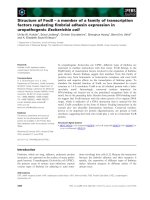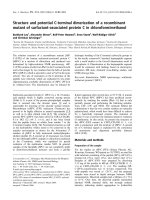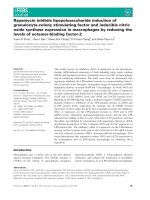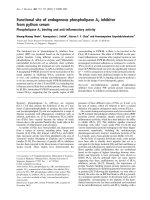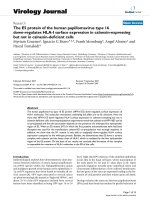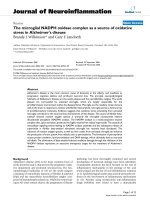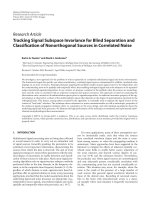Báo cáo y học: " tế ngành y học dành cho các bạn tham khảo đề tài: Early Oxidative stress increases Fas ligand expression in endothelial cells" ppt
Bạn đang xem bản rút gọn của tài liệu. Xem và tải ngay bản đầy đủ của tài liệu tại đây (495.72 KB, 8 trang )
BioMed Central
Page 1 of 8
(page number not for citation purposes)
Journal of Inflammation
Open Access
Research
Oxidative stress increases Fas ligand expression in endothelial cells
Mayumi Suzuki, Kazutetsu Aoshiba* and Atsushi Nagai
Address: First Department of Medicine, Tokyo Women's Medical University 8-1 Kawada-cho, Shinjuku-ku, Tokyo 162-8666, Japan
Email: Mayumi Suzuki - ; Kazutetsu Aoshiba* - ; Atsushi Nagai -
* Corresponding author
Abstract
Background: Fas ligand (FasL) induces apoptosis in Fas-bearing target cells, such as leukocytes,
and up-regulation of FasL expression on the endothelium may contribute to anti-inflammatory
reactions that attenuate leukocyte extravasation during inflammation. Since oxidants generated
during inflammation and cigarette smoking may modulate endothelial function, we examined the
effect of H
2
O
2
and cigarette smoke on endothelial FasL expression.
Methods: Human umbilical vein endothelial cells (HUVECs) were exposed to nontoxic
concentrations of H
2
O
2
and cigarette smoke extracts (CSE). Membrane FasL expression was
assessed by immunostaining with anti-FasL antibody followed by either monolayer-cell-based
spectrofluorimetry or flow cytometry. Soluble FasL in culture supernatants was measured by
enzyme-linked immunosorbent assay. For the cytotoxic assay, HUVECs were exposed to H
2
O
2
and
co-cultured with neutrophils. Neutrophils were stained by a peroxidase/diaminobenzidine-based
reaction, and apoptosis was evaluated on the basis of nuclear morphology after Giemsa staining.
To analyze in vitro FasL expression in arteries, rat thoracic aortas were incubated with H
2
O
2
, and
paraffin-embedded sections were prepared for immunohistochemistry with anti-FasL antibody.
Results: Exposure of HUVECs to H
2
O
2
dose-dependently increased their levels of both
membrane and soluble forms of FasL expression. CSE exposure also caused increased levels of FasL
expression, but the increase was partially inhibited by the addition of catalase. When co-cultured
with neutrophils, HUVECs exposed to H
2
O
2
significantly promoted neutrophil apoptosis. Rat
thoracic aortas incubated with H
2
O
2
exhibited increased FasL expression on their endothelium.
Conclusion: Low levels of oxidative stress increase FasL expression on endothelial cells, thereby
potentially reducing leukocyte extravasation and tissue damage.
Background
Fas ligand (FasL) is a type II membrane protein belonging
to the tumor necrosis factor (TNF) family that induces
apoptosis in target cells bearing the receptor Fas [1]. The
role of the Fas-FasL system has been best characterized in
the immune system. Interactions between Fas and FasL
are functionally involved in tissue-specific regulation of
various immune processes. For example, FasL expression
has been detected in immune-privileged tissues, such as
the eye and testis, which are protected from destructive
immune responses by inducing apoptosis of infiltrating
Fas-bearing immune cells [2]. In this way FasL expression
in some tissues contributes to their immune-privileged
status.
Published: 19 July 2006
Journal of Inflammation 2006, 3:11 doi:10.1186/1476-9255-3-11
Received: 23 January 2006
Accepted: 19 July 2006
This article is available from: />© 2006 Suzuki et al; licensee BioMed Central Ltd.
This is an Open Access article distributed under the terms of the Creative Commons Attribution License ( />),
which permits unrestricted use, distribution, and reproduction in any medium, provided the original work is properly cited.
Journal of Inflammation 2006, 3:11 />Page 2 of 8
(page number not for citation purposes)
Endothelial cells express Fas but are normally resistant to
Fas-mediated apoptosis [3,4]. On the other hand, recent
studies have shown that endothelial cells express FasL
constitutively and therefore regulate leukocyte extravasa-
tion [5]. Administration of the proinflammatory cytokine
TNFα down-regulates FasL expression on endothelial cells
and promotes inflammation, whereas over-expression of
FasL on the endothelium attenuates leukocyte extravasa-
tion [5]. FasL over-expression on the endothelium of
arteries also inhibits intimal hyperplasia and ischemia-
reperfusion injury in animals [6,7]. Thus, up-regulation of
FasL expression on the endothelium may contribute to
anti-inflammatory reactions by reducing leukocyte trans-
migration in tissue.
Oxidants are potential mediators involved in the regula-
tion of FasL expression. Oxidants are highly reactive com-
pounds generated during normal metabolism as well as in
various pathological states, such as inflammation,
ischemia/reperfusion injury, hyperoxia, and radiation
injury. Previous studies have shown that increased oxida-
tive stress induces FasL expression by T-lymphocytes [8],
microglial cells [9], and intestinal epithelial cells [10],
suggesting that oxidative stress is involved in the FasL-
mediated apoptotic mechanism of Fas-bearing target cells.
However, little information exists about the role of oxida-
tive stress in FasL expression by endothelial cells. Since
endothelial cells are targets of the oxidative stress gener-
ated by inflammatory cells, endothelial cells themselves,
and exogenous pro-oxidants, such as hyperoxia and ciga-
rette smoke [11], we investigated whether oxidative stress
up-regulates FasL expression in endothelial cells.
Methods
Preparation of the cigarette smoke extracts (CSE)
Aqueous CS extracts (CSE) were prepared by the method
described previously, with a modification [12]. Immedi-
ately before use, mainstream smoke was generated with
one cigarette (Peace
®
; Japan Tobacco Inc.) by drawing con-
secutive puffs into a 20-ml plastic syringe with a stopcock
connected through one port to a glass vessel containing 3
ml of phosphate-buffered saline (PBS). A 20-ml puff
drawn over 1 second was obtained at 10-second intervals.
Each puff was held for 3 seconds and bubbled through the
PBS for 5 seconds. One cigarette yielded an average of 45
puffs by this procedure. The aqueous CSE was diluted in
culture medium before use, and the CSE solutions were
prepared by the same person (M.S.) by exactly the same
method, and they were used within 5 minutes after prep-
aration.
Cell culture
Primary human umbilical vein endothelial cells
(HUVECs) were obtained from Clonetics (San Diego,
CA). Frozen cells were thawed, plated onto a 100-mm
dish (Falcon
®
Becton Dickinson Labware, Franklin Lakes,
NJ) precoated with bovine type I collagen (Vitrogen
®
;
Cohesion Technologies, Palo Alto, CA), and grown in
endothelial growth medium (EBM-2 containing hydro-
cortisone, hFGF-B, VEGF, R3-IGF-1, ascorbic acid,
heparin, 2% FBS, hEGF, gentamicin, and amphotericin B;
Clonetics CC-4176). When the cells reached 70% conflu-
ence, they were trypsinized with 0.1% trypsin (Gibco BRL
®
Life Technologies, Inc., Grand Island, NY), and 2% EDTA
(Gibco BRL
®
), neutralized with soybean trypsin inhibitor
(Gibco BRL
®
), rinsed once with PBS, and seeded onto a
new dish. Cells between passages 3 and 5 were used in the
experiments. Human neutrophils from EDTA-anticoagu-
lated venous blood specimens obtained from healthy vol-
unteers were isolated by dextran sedimentation and
centrifugation on a Histopaque gradient (without endo-
toxin; Sigma-Aldrich Japan, Tokyo, Japan), as previously
described [12]. The purity of the neutrophil populations
was >95% based on May-Grunewald-Giemsa staining,
and neutrophil viability determined by trypan blue dye
exclusion was >98%.
Cell treatment
HUVECs at a density of (10
4
cells/mm
2
) were plated onto
96-well plates (Falcon
®
), 8-well chamber slides (Lab-Tek
Nalge
®
Nunc International, Tokyo, Japan), or onto 60-mm
plates (Falcon
®
) precoated with type I collagen, and grown
in endothelial growth medium. When the cells reached
confluence, they were incubated for 8 hours with EBM-2
medium lacking growth factors, and then exposed to dif-
ferent concentrations of H
2
O
2
(Wako Pure Chemical
Industries, Ltd., Osaka, Japan) or CSE for 16 hours in the
presence or absence of catalase (500 U/ml; Sigma-
Aldrich). Cell viability after exposure to H
2
O
2
or CSE was
assessed by staining with 40 µg/ml of propidium iodide
(Sigma-Aldrich) and spectrofluorimetry at an excitation
wavelength of 530 nm and emission wavelength of 590
nm, as described previously [13].
Analysis of FasL expression
Membrane FasL expression in HUVECs was analyzed by
cell-monolayer-based spectrofluorimetry or flow cytome-
try. For cell monolayer-based spectrofluorimetry,
HUVECs cultured on 96-well plates (Falcon
®
) were fixed
with cold 1% paraformaldehyde for 15 min. After rinsing
with PBS, plates were blocked with blocking buffer (PBS
containing 3% bovine serum albumin and 2% goat
serum: Sigma-Aldrich) and incubated for 60 minutes at
room temperature with monoclonal mouse anti-FasL
antibody (NOK1, 8 µg/ml; Pharmingen, San Diego, CA)
or isotype-matched mouse nonimmune IgG in blocking
buffer. The plates were rinsed 3 times with PBS and incu-
bated with FITC-conjugated anti-mouse IgG antibody (5
µg/ml; Southern Biotechnology Associates, Inc., Briming-
ham, AL) for 1 hour at room temperature. Fluorescence
Journal of Inflammation 2006, 3:11 />Page 3 of 8
(page number not for citation purposes)
was measured on a Cytofluor II multiplate fluorometer
(Perceptive Biosystems, Framingham, MA) at an excita-
tion wavelength of 485 nm and emission wavelength of
530 nm.
For flow cytometry, cells were detached from 60-mm cul-
ture plates with 0.5% EDTA solution containing matrix
metalloproteinase inhibitor (KB8301, 10 µg/ml;
Pharmingen) and incubated for 1 hour at room tempera-
ture with anti-FasL mAb (NOK1, 8 µg/ml) or isotype-
matched mouse nonimmune IgG (Dako Cytomation
Japan, Tokyo, Japan) in blocking buffer. Cells were then
washed 3 times with PBS and stained with FITC-conju-
gated anti-mouse IgG antibody for 1 hour at room tem-
perature. FITC-labeled cells were detected using a flow
cytometer (FACS) on an FL-1 channel.
Amounts of soluble Fas L in samples of the supernatant
from the 96-well plate cultures of HUVECs were analyzed
by using a soluble FasL enzyme-linked immunosorbent
assay (ELISA) kit (R&D systems Inc., Minneapolis, MN)
according to manufacturer's instructions.
Cytotoxicity assay
The ability of FasL on endothelial cells to induce apopto-
sis in Fas-positive target cells was assessed by co-incubat-
ing neutrophils with HUVECs. HUVECs were grown to
confluence in 96-well plates and exposed to 100 µM H
2
O
2
for 16 hours. The plates were then washed 3 times with
PBS, and neutrophils (10
5
cells) suspended in EBM-2
medium lacking growth factors were added to HUVECs.
The plates were centrifuged at 200 × g for 2 minutes, and
after incubation at 37°C for 16 hours, non-adherent cells
were collected and attached to glass slides by cytocentrif-
ugation. The slides were fixed with a cold mixture of 60%
acetone and 2% glutaraldehyde, reacted with a solution
consisting of 250 µg/ml 3,3'-diaminobenzidine (Dako
Cytomation) and 0.01% H
2
O
2
for 10 minutes at room
temperature, and stained with a Giemsa solution. Apop-
totic neutrophils were identified as cells exhibiting
nuclear pyknosis or chromatin condensation [12]
together with brown-colored cytoplasmic staining when
examined by oil immersion microscopy. Three hundred
cells were scored in each experiment to determine the per-
centage of apoptotic neutrophils cells.
In vitro culture of rat thoracic aortas
The Animal Care and Use Committee of Tokyo Women's
Medical University approved the animal protocol. Tho-
racic aortas were obtained from male SD rats (Sankyo
Labo Service Co., Tokyo, Japan) weighing 250 g, and they
were cultured in the presence or absence of 100 µM H
2
O
2
for 16 hours in EBM-2 medium lacking growth factors.
The thoracic aortas were then fixed in 3% paraformalde-
Cell viability after exposure to H
2
O
2
and CSEFigure 1
Cell viability after exposure to H
2
O
2
and CSE. HUVECs were incubated for 16 hours in 96-well plates with or without
1–500 µM H
2
O
2
or 0.5–5% CSE. Non-adherent cells were removed, and the number of adherent cells was counted by propid-
ium iodide staining and spectrofluorimetry (13). **p < 0.01 vs cells not exposed to H
2
O
2
or CSE.
Journal of Inflammation 2006, 3:11 />Page 4 of 8
(page number not for citation purposes)
Membrane FasL expression on HUVECsFigure 2
Membrane FasL expression on HUVECs. HUVECs were incubated for 16 hours with or without 1–100 µM H
2
O
2
or
0.5% and 0.5 and 1% CSE, in the presence or absence of 500 U/ml catalase. Membrane FasL expression on HUVECs analyzed
by cell-monolayer-based spectrofluorimetry (A and B) and flow cytometry (C). (A and B) Data are reported as the means ± SEM
of the values obtained from 5 experiments. *p < 0.05, **p < 0.01 vs. cells not exposed to H
2
O
2
or CSE. †p < 0.05 vs cells
exposed to 1% CSE only. (C) Data are representative of 3 separate experiments. Background; fluorescence levels generated by
replacement of anti-FasL antibody with nonimmune IgG.
Journal of Inflammation 2006, 3:11 />Page 5 of 8
(page number not for citation purposes)
hyde, and paraffin-embedded specimens were cut into 3-
µm sections. Sections were deparaffinized, digested with a
pepsin solution (Research Genetics, Huntsville, AL) for 5
minutes at 40°C, and exposed to 3% H
2
O
2
for 20 minutes
to inhibit endogenous peroxidase. After blocking with 3%
bovine serum albumin and 2% goat serum, sections were
incubated with polyclonal rabbit anti-FasL antibody
(Wako Pure Chemical Industries, Ltd., Osaka, Japan) or
non-immune rabbit IgG (Dako Cytomation) for 1 hour at
room temperature. The primary antibody was reacted
with biotin-conjugated anti-rabbit IgG antibody and
streptavidin-horseradish peroxidase (Research Genetics).
Immunoreactants were visualized with a substrate solu-
tion of 3-amino-9-ethylcarbazole (Dako Cytomation)
and nuclear counterstaining with a hematoxylin solution.
Statistics
All data are reported as means ± SEM. The mean values
were compared by one-way analysis of variance (ANOVA)
with Fisher's protected least significance difference
(PLSD) post hoc analysis and the unpaired t test. A p value
< 0.05 was considered significant.
Results
Oxidative stress increases FasL expression by HUVECs
Since as shown in Figure 1, exposure to H
2
O
2
at concen-
trations of 1–100 µM and to CSE at concentrations of
0.5% and 1% did not affect HUVEC viability, we used
these concentrations of H
2
O
2
and CSE to assess their effect
on FasL expression. The results showed that exposure of
HUVECs to H
2
O
2
dose-dependently increased the level of
membrane FasL expression as assessed by cell-monolayer-
based spectrofluorimetry (Figure 2A), and flow cytometry
also showed an increased level of membrane FasL expres-
sion on HUVECs after H
2
O
2
exposure (Figure 2C). Since
cigarette smoke is an important source of oxidants that
may affect endothelial function, we investigated whether
CSE enhances membrane FasL expression by HUVECs. As
shown in Figure 2B, HUVEC exposure to 0.5% and 1%
CSE increased the level of membranous FasL expression.
The increase was significantly inhibited in the presence of
catalase, which catalyzes H
2
O
2
, suggesting that CSE
induces FasL expression at least in part by oxidative mech-
anisms.
Since membrane FasL is converted to a soluble form, we
measured the amount of soluble FasL released by
HUVECs exposed to H
2
O
2
. As shown in Figure 3, HUVEC
exposure to H
2
O
2
increased the amount of soluble FasL in
the culture medium.
Oxidative-stress-induced FasL expression by HUVECs
induces neutrophil apoptosis
To determine the functional capacity of HUVECs to
induce apoptosis, we quantified Fas-positive neutrophils
[14] co-cultured with HUVECs after exposure to H
2
O
2
. As
shown in Figure 4, exposure of HUVECs to 100 µM H
2
O
2
significantly promoted neutrophil apoptosis, suggesting
that oxidative stress renders HUVECs cytotoxic to neu-
trophils.
Oxidative stress increases FasL expression on the
endothelium of the thoracic aorta
The results obtained thus far had suggested that oxidative
stress enhanced FasL expression in a HUVEC monolayer.
We then investigated whether oxidative stress increases
FasL expression on the endothelium of vascular tissues
cultured in vitro. Since arteries have been shown to
express low levels of FasL [4], we obtained thoracic aortas
from rats and incubated them with or without 100 µM
H
2
O
2
. Very weak immunoreactivity against anti-FasL was
observed on the endothelium of thoracic aortas cultured
with medium alone (Figure 5A), whereas culturing the
thoracic aortas with H
2
O
2
considerably enhanced
endothelial immunoreactivity against anti-FasL (Figure
5B), suggesting that oxidative stress increases FasL expres-
sion on the endothelium of arteries.
Soluble FasL release by HUVECsFigure 3
Soluble FasL release by HUVECs. Supernatant samples
were obtained from cultures of HUVECs incubated for 16
hours with or without 1–100 µM H
2
O
2
. The amount of solu-
ble FasL in the samples was determined by ELISA. Data are
reported as the means ± SEM of values obtained from 5
experiments. *p < 0.05 vs. cells not exposed to H
2
O
2
.
Journal of Inflammation 2006, 3:11 />Page 6 of 8
(page number not for citation purposes)
Discussion
The results of the present study showed that oxidative
stress induced by nontoxic concentrations of H
2
O
2
and
cigarette smoke induces FasL expression on endothelial
cells. Increased exposure of the endothelium to oxidants
is involved in many pathological states, such as inflamma-
tion, ischemia/reperfusion, and atherosclerosis [11].
H
2
O
2
is one of the most important oxidants derived from
leukocytes and endothelial cells. It exerts a toxic effect on
susceptible cells at high concentrations, but alters cell
functions at low concentrations by modulating signal
transduction pathways in certain cells, including endothe-
lial cells [11]. Cigarette smoke is an important source of
oxidants, including H
2
O
2
, and is thought to be a signifi-
cant risk factor for chronic endothelial damage leading to
atherosclerosis [15]. Our results suggest that low oxidant
levels induce over-expression of FasL on the endothelium,
which prevents inflammatory cell infiltration in tissue.
This notion is consistent with our results showing that
H
2
O
2
-exposed endothelial cells have increased ability to
induce apoptosis in neutrophils bearing the Fas receptor
[14]. Thus, FasL expression induced by oxidative stress
may function to control inflammatory responses by
reducing leukocyte extravasation.
Our results corroborate those of previous studies examin-
ing the effect of oxidative stress on membrane FasL expres-
sion in different types of cells, including T-lymphocytes
[8], microglial cells [9], and intestinal epithelial cells [10].
However, the mechanism of FasL expression induced by
oxidative stress is unclear. A previous report documented
an association between oxidative stress-induced FasL
expression and NF-κB activation, although the functional
role of NF-κB has not been fully demonstrated [9,16].
Another possible mechanism of oxidative stress-induced
FasL expression is tyrosine phosphorylation of signaling
molecules, because tyrosine kinase-dependent signals,
such as p38 mitogen-activated protein kinase and Jun-N-
terminal kinase, have been implicated in FasL expression
[17]. This possibility is supported by our preliminary
experiments showing that H
2
O
2
-induced FasL expression
in endothelial cells is enhanced by vanadate, a protein
tyrosine kinase inhibitor, but reduced by genistein, a tyro-
sine kinase inhibitor (unpublished data).
Cytotoxicity toward neutrophils of HUVECs exposed to H
2
O
2
Figure 4
Cytotoxicity toward neutrophils of HUVECs exposed to H
2
O
2
. (A) A representative photomicrograph of neutrophils
cultured for 16 hours with 100 µM H
2
O
2
-pretreated HUVECs and stained with diaminobenzidine and Giemsa solutions. Arrows
point to apoptotic neutrophils with condensed and/or fragmented nuclei and cytoplasm positively stained with diaminobenzi-
dine (brown in the original photograph). Original magnification, × 1000. (B) The number of apoptotic neutrophils co-cultured
with HUVECs exposed to or not exposed to H
2
O
2
. Data are reported as the means ± SEM of values obtained from 5 experi-
ments. *p < 0.05 vs. cells not exposed to H
2
O
2
.
Journal of Inflammation 2006, 3:11 />Page 7 of 8
(page number not for citation purposes)
Our results show that exposing HUVECs to H
2
O
2
also
increases the production of soluble FasL. Although the
conversion of membranous FasL to its soluble form
reduces its pro-apoptotic activity [18], soluble Fas ligand
retains its capacity to interact with Fas, and serum concen-
trations of soluble FasL are related to the development of
vascular diseases. For example, a recent study has shown
that patients with familial combined hyperlipidemia or
carotid atherosclerosis have decreased serum FasL levels,
suggesting endothelial dysfunction that may allow leuko-
cyte infiltration of the vessel wall and lead to atheroscle-
rotic plaque formation [19]. In this context, the oxidative
stress-induced increase in endothelial soluble FasL pro-
duction observed in this study may contribute to main-
taining homeostasis of the systemic vasculature.
Oxidative stress has been shown to alter various aspects of
endothelial functions [11], for example, by increasing
endothelial adhesiveness to neutrophils via signaling
pathways dependent on activation of protein kinase C
[20], production of platelet-activating factor [21], and
expression of intracellular adhesion molecule-1 [22].
Thus, oxidative stress is generally thought to promote
endothelial injury by enhancing leukocyte adhesion to
the endothelium. In this sense, the endothelial FasL
expression in response to oxidative stress demonstrated in
this study may play a critical role in preventing endothe-
lial injury by inducing apoptosis of adhering leukocytes.
We found that the addition of catalase only reduced CSE-
induced FasL expression by HUVECs (Figure 2). Thus, an
oxidative mechanism mediated by species other than
H
2
O
2
or non-oxidative mechanisms may also be involved
in the increase in FasL expression by HUVECs after CSE
exposure [23]. Alternatively, CSE may have inhibited cat-
alase activity [24].
Conclusion
The results of our study show that oxidative stress induced
by nontoxic concentrations of H
2
O
2
and CSE increase
Immunohistochemistry of thoracic aortasFigure 5
Immunohistochemistry of thoracic aortas. Thoracic aortas were excised from rats and exposed to (B, C) or not exposed
to (A) 100 µM H
2
O
2
in vitro for 16 hours. Tissue sections were immunostained with rabbit polyclonal anti-FasL antibody, and
immunoreactants were visualized with a substrate solution of 3-amino-9-ethylcarbazole. Cell nuclei were counterstained with a
hemtoxylin solution. Exposure of thoracic aortas to 100 µM H
2
O
2
increased expression of FasL on the aortic endothelium (B).
Arrows point to positive FasL staining (red color in the original photomicrograph). Replacement of anti-FasL antibody with non-
immune rabbit IgG resulted in negative staining (C). Photographs are representative of immunostaining of three thoracic aorta
specimens Original magnification, 200×.
Publish with Bio Med Central and every
scientist can read your work free of charge
"BioMed Central will be the most significant development for
disseminating the results of biomedical research in our lifetime."
Sir Paul Nurse, Cancer Research UK
Your research papers will be:
available free of charge to the entire biomedical community
peer reviewed and published immediately upon acceptance
cited in PubMed and archived on PubMed Central
yours — you keep the copyright
Submit your manuscript here:
/>BioMedcentral
Journal of Inflammation 2006, 3:11 />Page 8 of 8
(page number not for citation purposes)
FasL expression in endothelial cells. This effect may con-
tribute to reductions in leukocyte-mediated inflammation
and tissue damage.
Competing interests
The author(s) declare that they have no competing inter-
ests.
Authors' contributions
SM and KA carried out all of the experiments reported in
this manuscript. NA participated design of the study.
Acknowledgements
The authors are very grateful to Masayuki Shino and Yoshimi Sugimura for
their excellent technical assistance.
References
1. Nagata S, Golstein P: The Fas death receptor. Science 1995,
267:1449-1456.
2. Griffith TS, Brunner T, Fletcher SM, Green DR, Fergunson PA: Fas
ligand-induced apoptosis as a mechanism of immune privi-
lege. Science 1995, 270:1189-1192.
3. Richardson BC, Lalwani ND, Johnson KJ, Marks RM: Fas ligation
triggers apoptosis in macrophages but not endothelial cells.
Eur J Immunol 1994, 24:2640-2645.
4. Sata M, Suhara T, Walsh K: Vascular endothelial cells and
smooth muscle cells differ in expression of Fas and Fas ligand
and in sensitivity to Fas ligand-induced cell death: implica-
tions for vascular disease and therapy. Arterioscler Thromb Vasc
Biol 2000, 20:309-316.
5. Sata M, Walsh K: TNFα regulation of Fas ligand expression on
the vascular endothelium modulates leukocyte extravasa-
tion. Nat Med 1998, 4:415-420.
6. Sata M, Luo Z, Walsh K: Fas ligand over-expression on allograft
endothelium inhibits inflammatory cell infiltration and
transplant-associated intimal hyperplasia. J Immunol 2001,
166:6964-71.
7. Yang J, Jones SP, Suhara T, Greer JJM, Ware PD, Nguyen NP, Perlman
H, Nelson DP, Lefer DJ, Walsh K: Endothelial cell overexpres-
sion of Fas ligand attenuates ischemia-reperfusion injury in
the heart. J Biol Chem 2003, 278:15185-15191.
8. Bauer MKA, Vogt M, Los M, Siegel J, Wesselborg S, Schulze-Osthoff
K: Role of reactive oxygen intermediates in activation-
induced CD95 (APO-1/Fas) ligand expression. J Biol Chem
1998, 14:8048-8055.
9. Vogt M, Bauer MKA, Ferrari D, Schulze-Osthoff K: Oxidative stress
and hypoxia trigger CD95 (APO-1/Fas) ligand expression in
microglial cells. FEBS 1998, 429:67-72.
10. Denning TL, Takaishi H, Crowe SE, Boldogh I, Jevnikar A, Ernst PB:
Oxidative stress induces the expression of Fas and Fas ligand
and apoptosis in murine intestinal epithelial cells. Free Radic
Biol Med 2002, 33:1641-1650.
11. Wolin MS: Reactive oxygen species and vascular signal trans-
duction mechanisms. Microcirculation 1996, 3:1-17.
12. Aoshiba K, Nagai A, Konno K: Nicotine prevents a reduction in
neutrophil filterability induced by cigarette smoke exposure.
Am J Respir Crit Care Med 1994, 150:1101-1107.
13. Skehan P: Assays of cell growth and cytotoxicity. In Cell Growth
and Apoptosis Edited by: Studzinski GP. Oxford, Oxford University
Press; 1995:169-191.
14. Liles WC, Kiener PA, Ledbetter JA, Aruffo A, Kleanoff SJ: Differen-
tial expression of Fas (CD95) and Fas ligand on normal
human phagocytes: implications for the regulation of apop-
tosis in neutrophils. J Exp Med 1996, 184:429-40.
15. Pryor WA, Stone K: Oxidants in cigarette smoke: radicals,
hydrogen peroxide, peroxynitrate, and peroxynitrite. Ann NY
Acad Sci 1993, 686:12-28.
16. Uchihara K, Wada T, Hoshino S, Nagakawa Y, Aiko T, Bulkley GB,
Klein AS, Sun Z: Lipopolysaccharaides induced increases in Fas
ligand expression by Kupffer cells via mechanisms depend-
ent on reactive oxygen species. Am J Physiol Gastrointest Liver Phys-
iol 2004, 287:G620-G626.
17. Hsu SC, Gavrilin MA, Tsai MH, Han J, Lai MZ: p38 mitogen-acti-
vated protein kinase is involved in Fas ligand expression. J Biol
Chem 1999, 274:25679-25776.
18. Schneider P, Holler N, Bodmer JL, Hahne M, Frei K, Fontana A,
Tschopp J: Conversion of membrane-bound Fas (CD95) ligand
to its soluble form is associated with downregulation of its
proapoptotic activity and loss of liver toxicity. J Exp Med 1998,
187:1205-13.
19. Blanco-Colio LM, Martin-Ventura JL, Sol JM, Diaz C, Hernandez G,
Egido J: Decreased circulating Fas ligand in patients with
familial combined hyperlipidemia or carotid atherosclerosis.
J Am Col Cardiol 2004, 43:118-1194.
20. Taher MM, Garcia JGN, Natarajan V: Hydroperoxide-induced dia-
cylglycerol formation and protein kinase C activation in vas-
cular endothelial cells. Arch Biochem Biophys 1993, 303:260-266.
21. Lewis MS, Whatley RE, Cain P, Mclntyre TM, Prescott S, Zimmerman
GA: Hydrogen peroxide stimulates the synthesis of platelet-
activating factor by endothelium and induces endothelial
cell-dependent neutrophil adhesion. J Clin Invest 1988,
82:2044-2055.
22. Lo SK, Janakidevi K, Lai L, Malik AB: Hydrogen peroxide-induced
increase in endothelial adhesiveness is dependent on ICAM-
activation. Am J Physiol Lung Cell Mol Physiol 1993, 264:L406-L4121.
23. Ramage L, Jones AC, Whelan CJ: Induction of apoptosis with
tobacco smoke and related products in A549 lung epithe-
lium cells in vitro. J Inflamm 2006, 3:3.
24. Mendez-Alvarez E, Soto-Otero R, Sanchez-Sellero I, Lopez-Rivadulla
Lamas M: In vitro inhibition of catalase activity by cigarette
smoke: relevance for oxidative stress. J Appl Toxicol 1998,
18:443-448.
